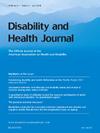Examining the effects of home modifications on perceptions of exertion and safety among people with mobility disabilities
IF 3.7
2区 医学
Q1 HEALTH CARE SCIENCES & SERVICES
引用次数: 0
Abstract
Background
People with mobility disabilities often have reduced stamina and limited energy, making daily activities physically demanding. Home modifications, such as installing grab bars and optimizing the environment, have the potential to reduce exertion and enhance safety in the home, enabling individuals to participate more in other activities.
Objective
The purpose of this study was to evaluate the effects of a home modification intervention on perceptions of exertion and safety among people with mobility disabilities.
Methods
The study utilized the Home Usability Program (HUP), which aims to improve accessibility, safety, and independence in participants' homes. Participants were recruited from four Centers for Independent Living (CILs) across the US and underwent a comprehensive assessment to identify consumer-directed, individualized home modifications. Surveys examining safety and exertion, in addition to qualitative interviews, were conducted to explore the impact of the intervention on participants’ energy levels and feelings of safety.
Results
Analysis of pre-post measures and participant interviews revealed that the HUP intervention resulted in decreased exertion. Decreased exertion had positive outcomes, including increased time for other activities, improved socialization, enhanced independence, and the potential for engaging in activities outside the home. Additionally, the HUP intervention led to increased safety, which positively affected mental well-being and independence.
Conclusions
Findings highlight the need for useable living environments that minimize physical strain and reduce exertion. Policy recommendations include prioritizing accessibility standards for housing, implementing individualized assessments for funding home modifications, providing financial assistance options, and allocating research funding for innovative solutions and technologies.
研究家庭改造对行动不便者的体力和安全感的影响
行动不便的人通常耐力不足,精力有限,日常活动对体力要求很高。家庭改造,如安装抓杆和优化环境,有可能减少劳累,提高家庭安全,使个人能够更多地参与其他活动。目的本研究的目的是评估家庭改造干预对行动障碍者运动和安全感知的影响。方法本研究采用家庭可用性计划(HUP),旨在改善参与者家中的可达性、安全性和独立性。参与者是从美国四个独立生活中心(CILs)招募的,并进行了全面的评估,以确定以消费者为导向的个性化家居改造。除了定性访谈外,研究人员还进行了安全性和努力程度的调查,以探讨干预对参与者的能量水平和安全感的影响。结果分析前后测量和参与者访谈显示,HUP干预导致体力消耗减少。减少劳累有积极的结果,包括增加了其他活动的时间,改善了社交,增强了独立性,并有可能参与家庭以外的活动。此外,HUP干预还增加了安全性,这对心理健康和独立性产生了积极影响。结论:研究结果强调,需要一个可用的生活环境,以尽量减少身体压力和减少劳累。政策建议包括优先考虑住房无障碍标准,为资助住房改造实施个性化评估,提供财政援助选择,以及为创新解决方案和技术分配研究资金。
本文章由计算机程序翻译,如有差异,请以英文原文为准。
求助全文
约1分钟内获得全文
求助全文
来源期刊

Disability and Health Journal
HEALTH CARE SCIENCES & SERVICES-PUBLIC, ENVIRONMENTAL & OCCUPATIONAL HEALTH
CiteScore
7.50
自引率
6.70%
发文量
134
审稿时长
34 days
期刊介绍:
Disability and Health Journal is a scientific, scholarly, and multidisciplinary journal for reporting original contributions that advance knowledge in disability and health. Topics may be related to global health, quality of life, and specific health conditions as they relate to disability. Such contributions include:
• Reports of empirical research on the characteristics of persons with disabilities, environment, health outcomes, and determinants of health
• Reports of empirical research on the Systematic or other evidence-based reviews and tightly conceived theoretical interpretations of research literature
• Reports of empirical research on the Evaluative research on new interventions, technologies, and programs
• Reports of empirical research on the Reports on issues or policies affecting the health and/or quality of life for persons with disabilities, using a scientific base.
 求助内容:
求助内容: 应助结果提醒方式:
应助结果提醒方式:


